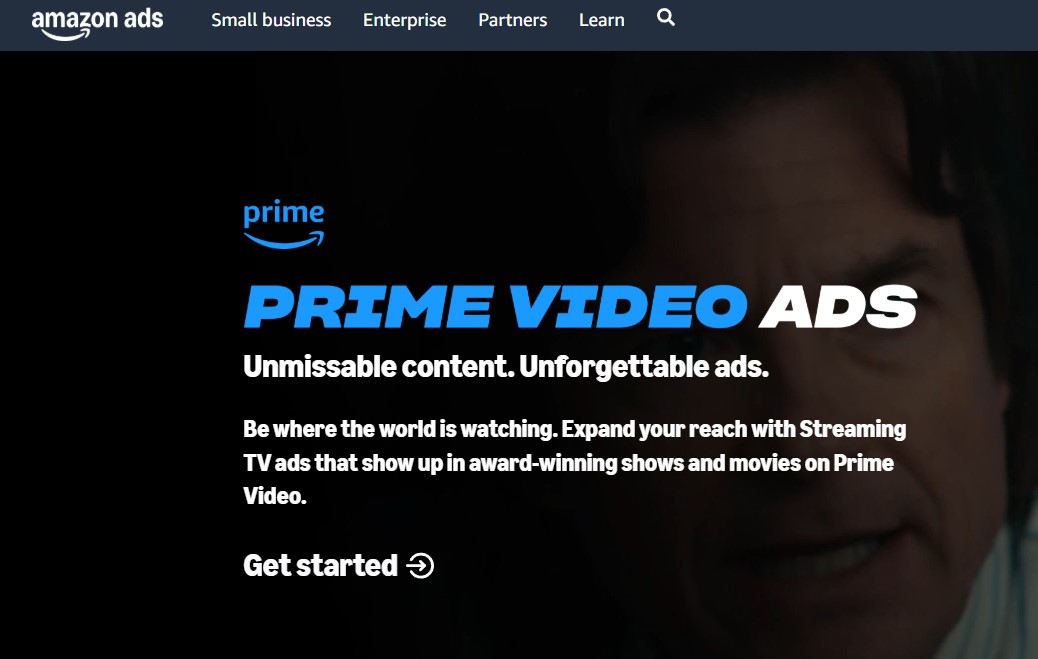January 12, 2025
Prepare for More Amazon Prime Video Ads in 2025

Greg Kopyltsov
Founder
amazon prime video to increase ad frequency in 2025


Get ready for more ads while you binge-watch. Amazon is set to increase the ad load a little bit on its Prime Video platform significantly in 2025, as vice president of advertising Kelly Day has indicated. The move signals a strategic shift as the retail giant seeks to capitalize on its massive user base and compete more aggressively in the increasingly competitive world of digital advertising through Amazon Ads. But what will this mean for Prime Video viewers?

While Amazon Prime Video initially distinguished itself with an ad-light environment compared to other streaming platforms, the landscape has changed. The company has begun incorporating more ads under the guidance of the vice president of Prime Video International, gradually acclimating viewers to their presence.
This transition isn't entirely unexpected. As streaming competition intensifies, even established platforms are under pressure to generate multiple revenue streams. Advertising, with its potential for high returns, has become increasingly attractive, even if it risks potentially turning off some subscribers.
Amazon's advertising journey didn't begin with Prime Video. The company has a well-established history of integrating advertising into its e-commerce platform through sponsored products, display ads, and its sophisticated Amazon DSP. This robust ad tech infrastructure has fueled Amazon's ascent in the digital advertising space.
Through the Amazon Marketing Cloud (AMC), ads data manager, and Amazon Publisher Cloud, advertisers have access to vast data troves, enabling them to target consumers with remarkable precision. This allows for the delivery of highly relevant ads to shoppers based on their browsing history, past purchases, and demonstrated interests.
Now, with the expansion of advertising on Prime Video, Amazon is strategically leveraging its existing infrastructure and experience to tap into the lucrative world of streaming advertising.
The rise of streaming services initially promised an escape from traditional television advertising. Consumers, enticed by the allure of ad-free viewing and premium content, flocked to platforms like Disney that disrupted the status quo. However, maintaining this model while continuously investing in new content has proven challenging.
To strike a balance, streaming platforms like Amazon have gradually introduced light ad loads, often around premium content or live events. This gentle entry of advertising into the streaming world has paved the way for more significant integration in recent years.
Now, viewers are encountering ads with greater frequency. This trend, driven by the need for alternative revenue streams and competitive pressures, marks a significant shift in the streaming industry's landscape, signaling a future where advertising plays a more prominent role in the user experience.
Amazon's plans for Prime Video advertising in 2025 extend beyond simply increasing the number of ads in countries like Brazil and India. The company is focused on delivering a more sophisticated and integrated advertising experience. It starts with a wider variety of ad formats, offering advertisers more creative options to engage Prime Video viewers.
Furthermore, Amazon is developing targeting and personalization technologies designed to ensure viewers see more relevant ads. The goal is to create a less disruptive and potentially even valuable advertising experience within Prime Video.
As part of its advertising expansion in Austin, Amazon is rolling out a series of innovations designed to provide brands with more options and control over their campaigns. These enhancements will introduce new ad formats and enhance campaign management tools for advertisers.
Expect to see:
Amazon plans to leverage its vast data resources, including Twitch, to enhance targeting and personalization in Prime Video ad campaigns. The company's understanding of consumer behavior, purchasing habits, and viewing preferences will allow advertisers to reach their target audience with exceptional precision.
This precise reach will be central to Amazon's strategy, enabling advertisers to refine their campaign goals and align them closely with overall marketing goals. By delivering relevant ads to the right viewers at the right time, Amazon aims to maximize campaign effectiveness for its advertising partners, taking full-funnel measurement and direct measurement insights to center stage.
Through sophisticated data analysis, Amazon seeks to create a more seamless and engaging advertising experience, ensuring that Prime Video ads resonate with viewers while minimizing disruption.
The increase in ads on Prime Video will undoubtedly impact the viewer experience. While Amazon has emphasized its commitment to a balanced approach, some viewers may find the increased ad load intrusive. This raises concerns about the potential for subscriber churn if viewers perceive the advertising as excessive or disruptive.
In response, Amazon is exploring various subscription models and options to address these concerns, aiming to offer choices that cater to a wide range of viewer preferences while balancing its revenue goals.
How Prime Video viewers ultimately respond to the increased ad load remains to be seen. While many are accustomed to ads on other platforms, the initial appeal of ad-free streaming may lead to resistance. Amazon is acutely aware of this potential pitfall and will likely closely monitor viewer engagement metrics to gauge the impact of its advertising strategy.
Early indicators suggest that viewers are more tolerant of advertising when it is relevant to their interests and seamlessly integrated into their viewing experience. This emphasizes the importance of Amazon's focus on targeting and personalization.
Striking the right balance between ad load and viewer experience will be critical for Amazon's continued success in the streaming market. The company will need to carefully consider the potential impact on Prime Video viewers and adjust its subscription models accordingly to retain and attract subscribers.
While incorporating advertising more prominently into its Prime Video platform, Amazon understands that ad-free viewing remains a significant draw for many subscribers. The company is exploring subscription options to cater to varied viewer preferences and maximize subscriber retention.
Rumors about the introduction of a premium tier offering completely ad-free viewing are circulating, indicating Amazon's commitment to providing choices. This potential tier would likely come at a higher price point, giving subscribers greater control over their viewing experience while providing Amazon with an additional revenue stream.
By offering a range of subscription options, Amazon aims to balance its revenue objectives with its commitment to subscriber satisfaction. The flexibility of multiple tiers will be crucial for Amazon to navigate the evolving streaming landscape successfully.

The move to increase advertising on Prime Video is a strategic decision driven by several factors. First and foremost, it allows Amazon to enhance revenue streams beyond its core e-commerce business and subscription services. As the streaming market matures, generating revenue beyond subscriptions is essential for sustaining content investments and remaining competitive.
Additionally, advertising provides valuable data insights that Amazon can leverage to its advantage. This data can refine its targeting capabilities, improve ad relevance, and inform content production decisions, creating a more profitable and competitive ecosystem.
Amazon's decision to increase Prime Video advertising is primarily driven by the opportunity to enhance revenue streams, especially with popular events like Thursday Night Football. A report by the Financial Times revealed that Amazon is projecting a significant increase in advertising revenue, solidifying its position as a dominant player in the digital advertising landscape.
This injection of advertising dollars could offset rising customer acquisition costs and allow for greater investment in original content, a key differentiator in the competitive streaming market. The additional revenue could also subsidize Prime membership costs, making it more attractive, especially as competitors raise prices.
By diversifying revenue streams, Amazon is strategically positioning itself for sustainable growth in the ever-evolving digital entertainment market.
While revenue generation drives Amazon's advertising strategy, the company is also focused on balancing ad integration with a positive user experience. A gradual increase in ad load over time represents a gentle entry into a more ad-supported model, allowing viewers to acclimate as the platform evolves.
Amazon is emphasizing fewer ads through less intrusive ad formats and limiting ad breaks compared to traditional TV and other TV providers, aiming for a less disruptive experience. In addition, the focus on relevance through advanced targeting and personalization ensures that ads are more likely to resonate with viewers.
The success of this strategy hinges on finding the sweet spot between delivering value to advertisers while maintaining viewer engagement and satisfaction with Prime Video.
KeywordSearch has an AI Audience builder that helps you create the best ad audiences for YouTube & Google ads in seconds. In a just a few clicks, our AI algorithm analyzes your business, audience data, uncovers hidden patterns, and identifies the most relevant and high-performing audiences for your Google & YouTube Ad campaigns.
You can also use KeywordSearch to Discover the Best Keywords to rank your YouTube Videos, Websites with SEO & Even Discover Keywords for Google & YouTube Ads.
If you’re looking to SuperCharge Your Ad Audiences with AI - Sign up for KeywordSearch.com for a 5 Day Free Trial Today!
In conclusion, as Amazon Prime Video gears up for more ad integration in 2025, the landscape of streaming advertising is set to evolve significantly. With a focus on enhancing revenue streams and balancing user experience, Amazon aims to offer targeted and personalized ad campaigns, including insights from their frequency cap insights report, which may also consider ad frequency at a household level. While this shift may impact viewer reception and subscription options, it also presents opportunities for advertisers to reach specific demographics effectively. As we anticipate these changes, understanding Amazon's strategy behind this move will be crucial for both viewers and stakeholders in the streaming industry. Stay informed and prepared for the future of Amazon Prime Video advertisements.